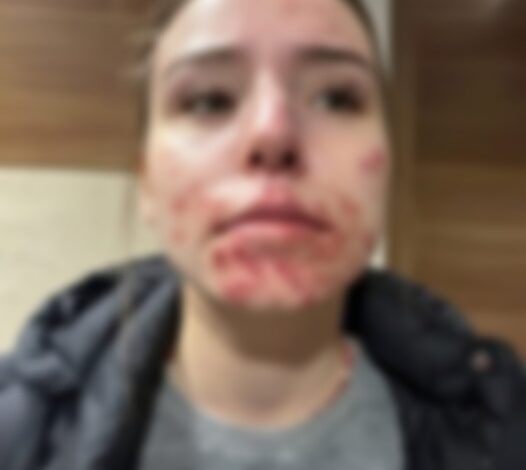
At first glance, it might look like a harmless quirk — faint, lace-like patches spreading across the skin in shades of purple, blue, or red. But for many people, these mysterious patterns, known as livedo reticularis, are more than just a cosmetic curiosity. Sometimes, they’re an early warning sign that something deeper is wrong.
While often benign and temporary, livedo reticularis can also be the skin’s way of signaling serious underlying issues — including autoimmune disorders, circulatory problems, or clotting abnormalities. Understanding the difference between what’s harmless and what’s not could make all the difference.
What Exactly Is Livedo Reticularis?
Livedo reticularis describes a net-like, mottled discoloration that appears most commonly on the legs, arms, or torso. It happens when blood in the tiny vessels under the skin flows unevenly or pools, creating those distinctive purple or reddish patterns where oxygen supply dips.
In cold weather, the pattern may become more visible, only to fade as the skin warms. Many people shrug it off as poor circulation — and sometimes, that’s all it is. But in persistent or recurring cases, it can point to something far more significant.
Two Faces of Livedo Reticularis
1. Primary (Physiological) Livedo Reticularis
This is the mild, typically harmless form. It’s triggered by exposure to cold and is especially common among fair-skinned individuals, children, and young adults. The pattern usually fades once the body warms up and doesn’t require medical treatment.
2. Secondary (Pathological) Livedo Reticularis
This version doesn’t fade with warmth — and that’s a red flag. Persistent discoloration can indicate an underlying vascular, autoimmune, or hematologic condition that disrupts normal blood flow. In such cases, livedo reticularis isn’t just a skin symptom — it’s a clue pointing to a deeper issue that demands medical evaluation.
What Causes It?
The causes of livedo reticularis range from harmless to life-threatening. They can include:
- Cold exposure: The most common and benign trigger, as blood vessels constrict in low temperatures.
- Vascular diseases: Disorders like vasculitis or peripheral artery disease that impair circulation.
- Autoimmune diseases: Conditions such as lupus, rheumatoid arthritis, or antiphospholipid syndrome can inflame or restrict blood vessels.
- Blood clotting disorders: Problems like thrombophilia may cause uneven blood flow and mottled skin.
- Medication side effects: Certain drugs, particularly those used for Parkinson’s disease or hypertension, can provoke vascular reactions that mimic livedo.
- Rare systemic illnesses: In uncommon cases, it’s linked to severe conditions like Sneddon’s syndrome, polyarteritis nodosa, or cholesterol embolization, all of which can threaten multiple organs.
What to Look For
The tell-tale sign is the characteristic net-like pattern. But if it’s accompanied by other symptoms, that’s when you should take notice.
Watch for:
- Skin that stays cold, numb, or discolored even in warmth
- Pain, cramping, or heaviness in the legs
- Development of ulcers, sores, or blisters
- Headaches, vision problems, or neurological issues, which could suggest systemic involvement
A pattern that fades quickly when you warm up is likely harmless. But if it persists or spreads, it’s time to call your doctor.
How Doctors Diagnose It
A medical evaluation for livedo reticularis starts with a physical examination and a deep dive into your medical and family history. From there, your doctor may order tests to determine whether the condition is benign or linked to something serious.
Common diagnostic steps include:
- Blood tests: To look for signs of autoimmune disease, clotting issues, or inflammation.
- Skin biopsy: Rare but sometimes necessary, to check for vascular inflammation or damage.
- Imaging studies: Doppler ultrasound or CT scans can evaluate circulation and rule out vascular blockages.
The goal is simple: identify the cause early before it leads to complications elsewhere in the body.
Treatment Options
How livedo reticularis is treated depends entirely on its cause.
If It’s Primary (Benign) Livedo
No medical intervention is usually needed. Managing it often means keeping warm, staying hydrated, and avoiding sudden exposure to cold. Over time, the discoloration fades.
If It’s Secondary (Linked to Illness)
Treatment focuses on targeting the root cause:
- Anticoagulants like warfarin or heparin may be prescribed to prevent blood clots.
- Corticosteroids or immunosuppressants are used when autoimmune disorders are to blame.
- Vasodilators or circulation-boosting medications may help in cases related to vascular disease.
- Lifestyle changes — quitting smoking, maintaining a healthy weight, exercising regularly, and managing cholesterol — can significantly reduce symptoms and risks.
A doctor may also recommend follow-ups with specialists such as a rheumatologist, dermatologist, or vascular surgeon depending on the findings.
When to Seek Medical Help
You should schedule a medical appointment if you notice:
- Discoloration that doesn’t fade after warming
- Persistent pain, sores, or skin ulcers
- Symptoms of fatigue, joint pain, or neurological changes
- Any sudden or unexplained pattern that appears without cold exposure
Livedo reticularis by itself isn’t always dangerous. But when it lingers or evolves alongside other symptoms, it could be your body’s first distress signal — one you shouldn’t ignore.
Why It Matters
Your skin isn’t just a surface — it’s a mirror of your internal health. Changes in color, texture, or pattern often precede deeper medical problems. Conditions like autoimmune diseases, blood clotting disorders, or vascular inflammation can first show up as subtle skin changes long before internal symptoms appear.



